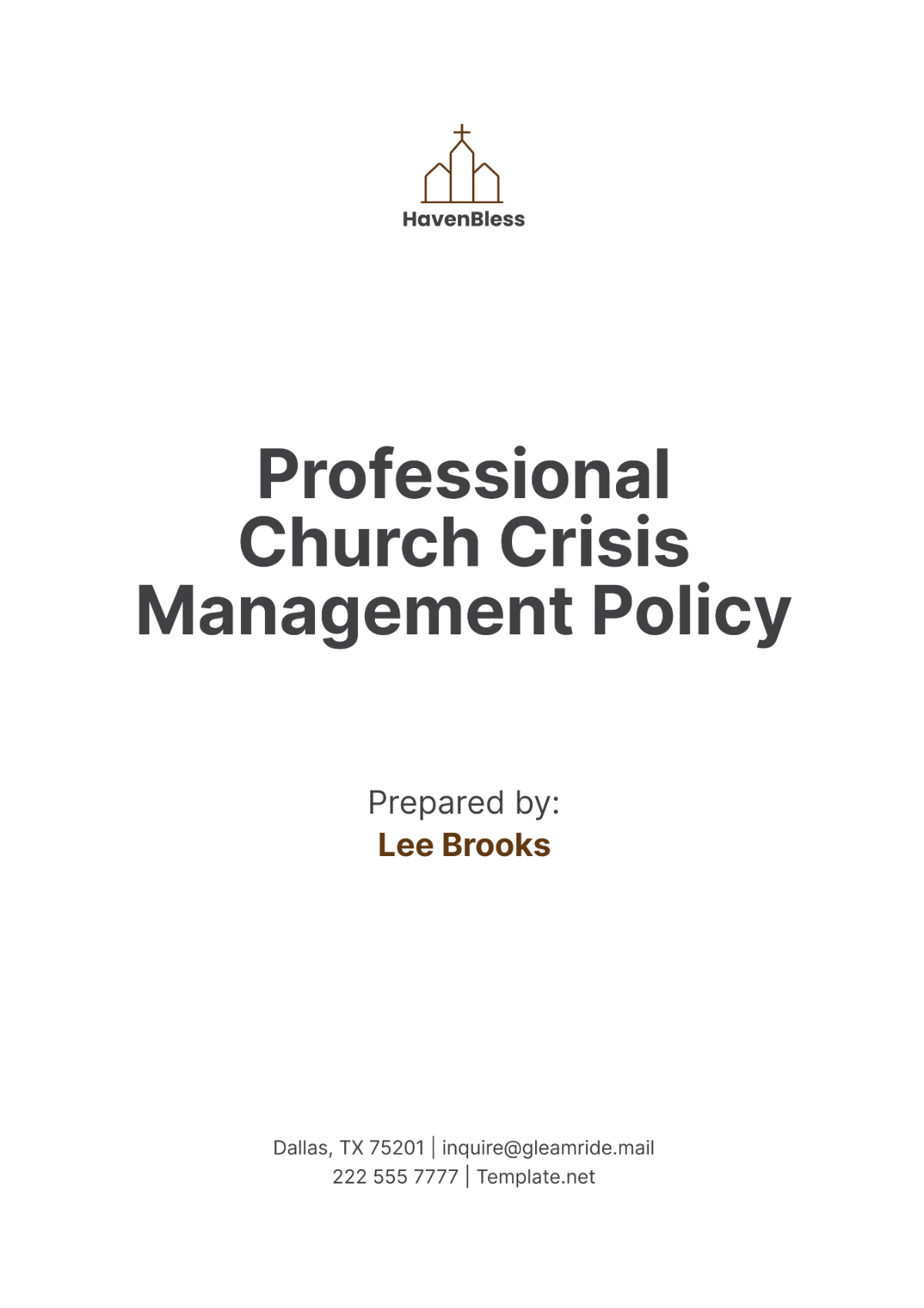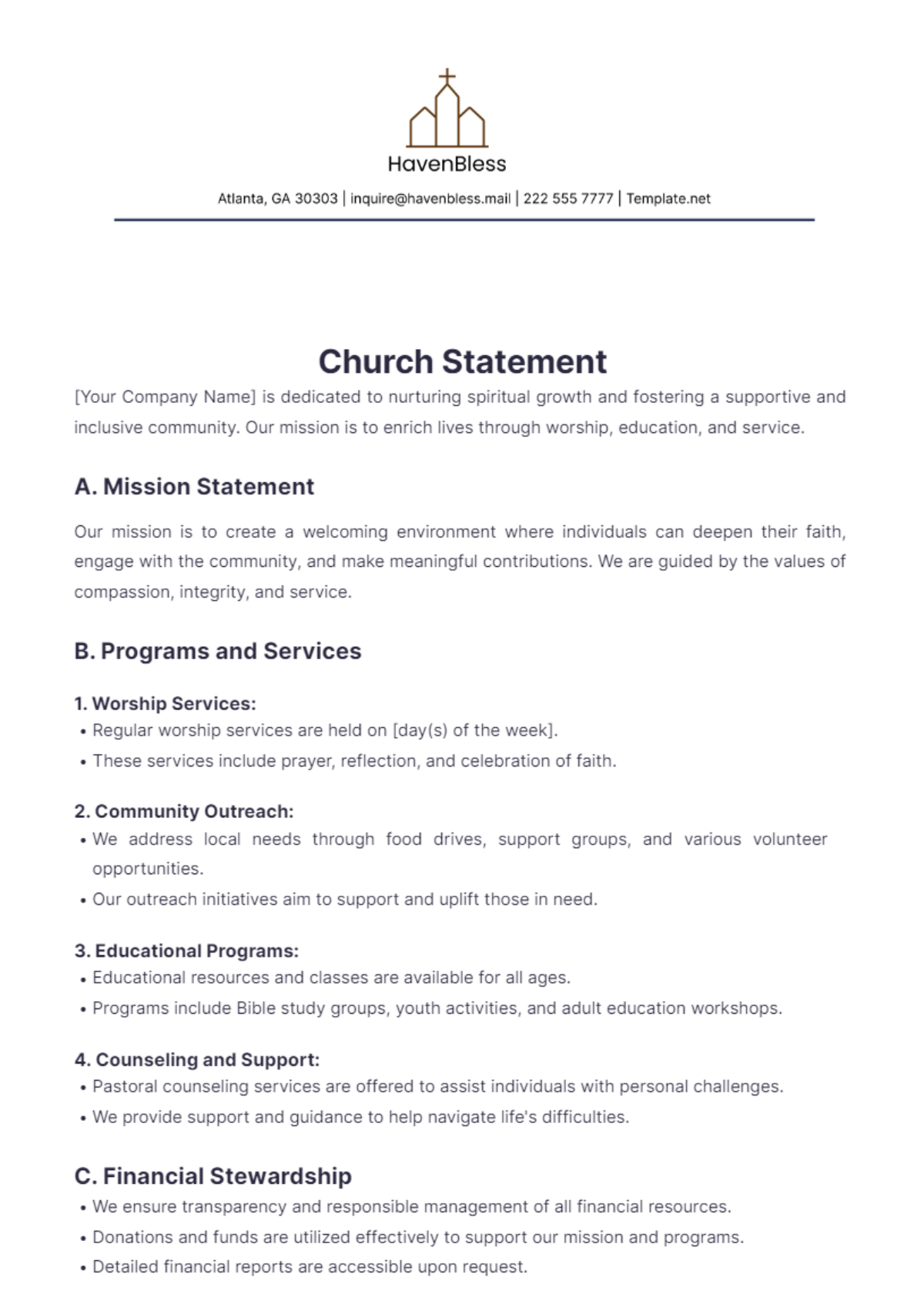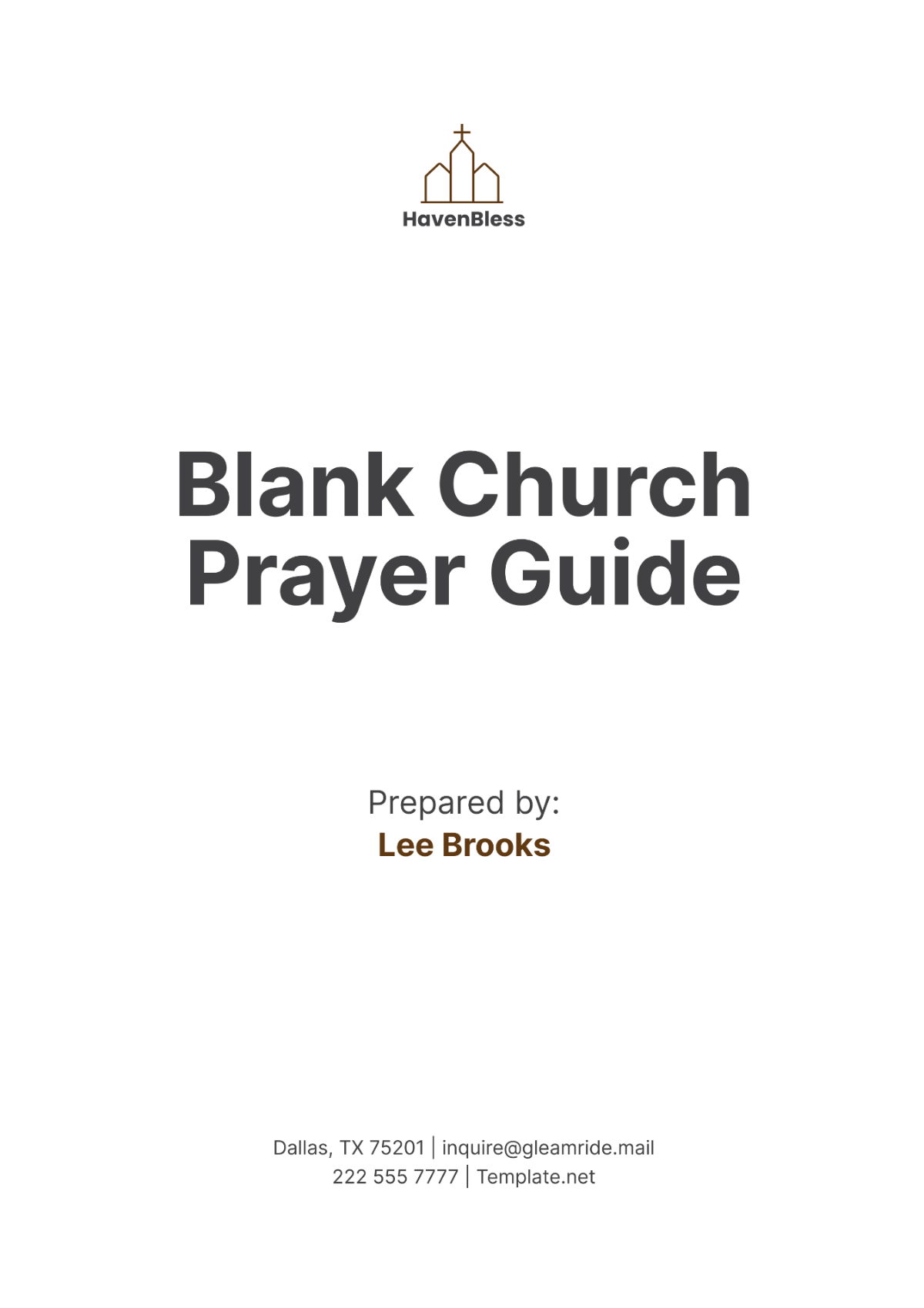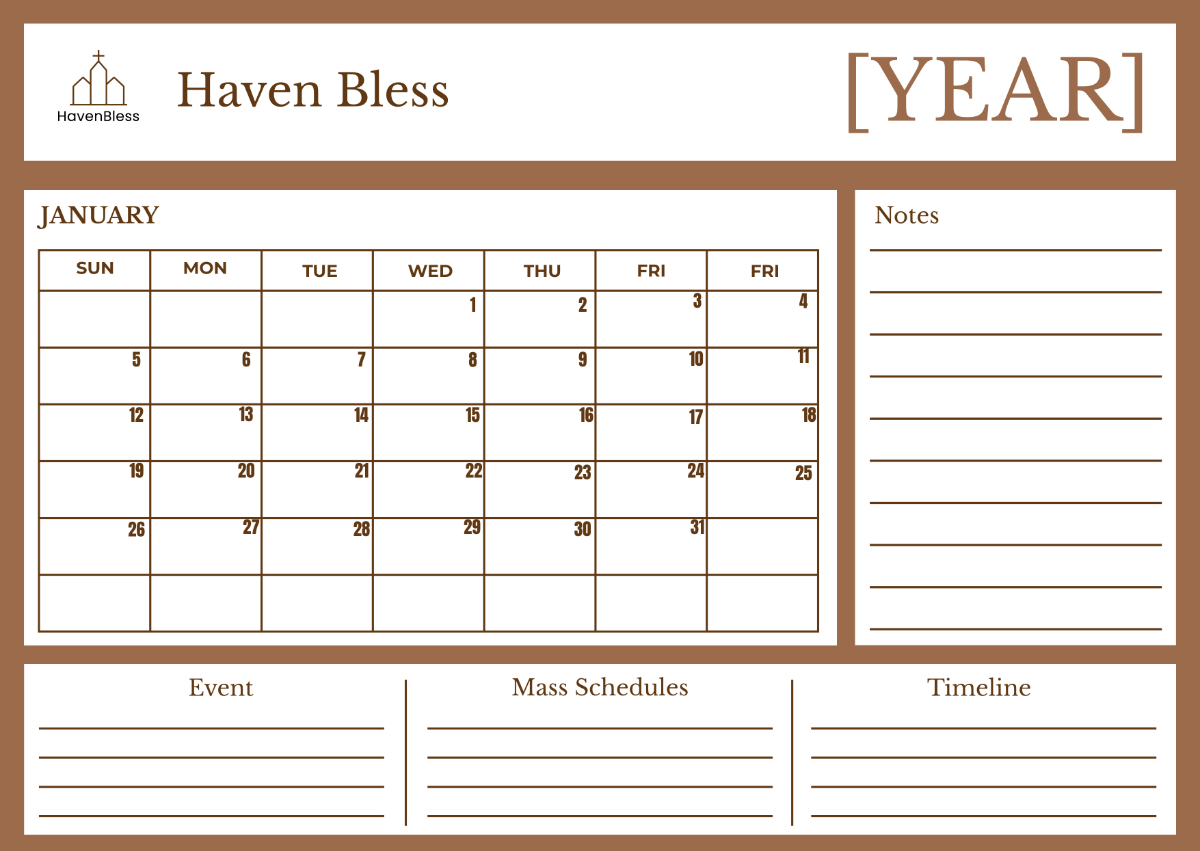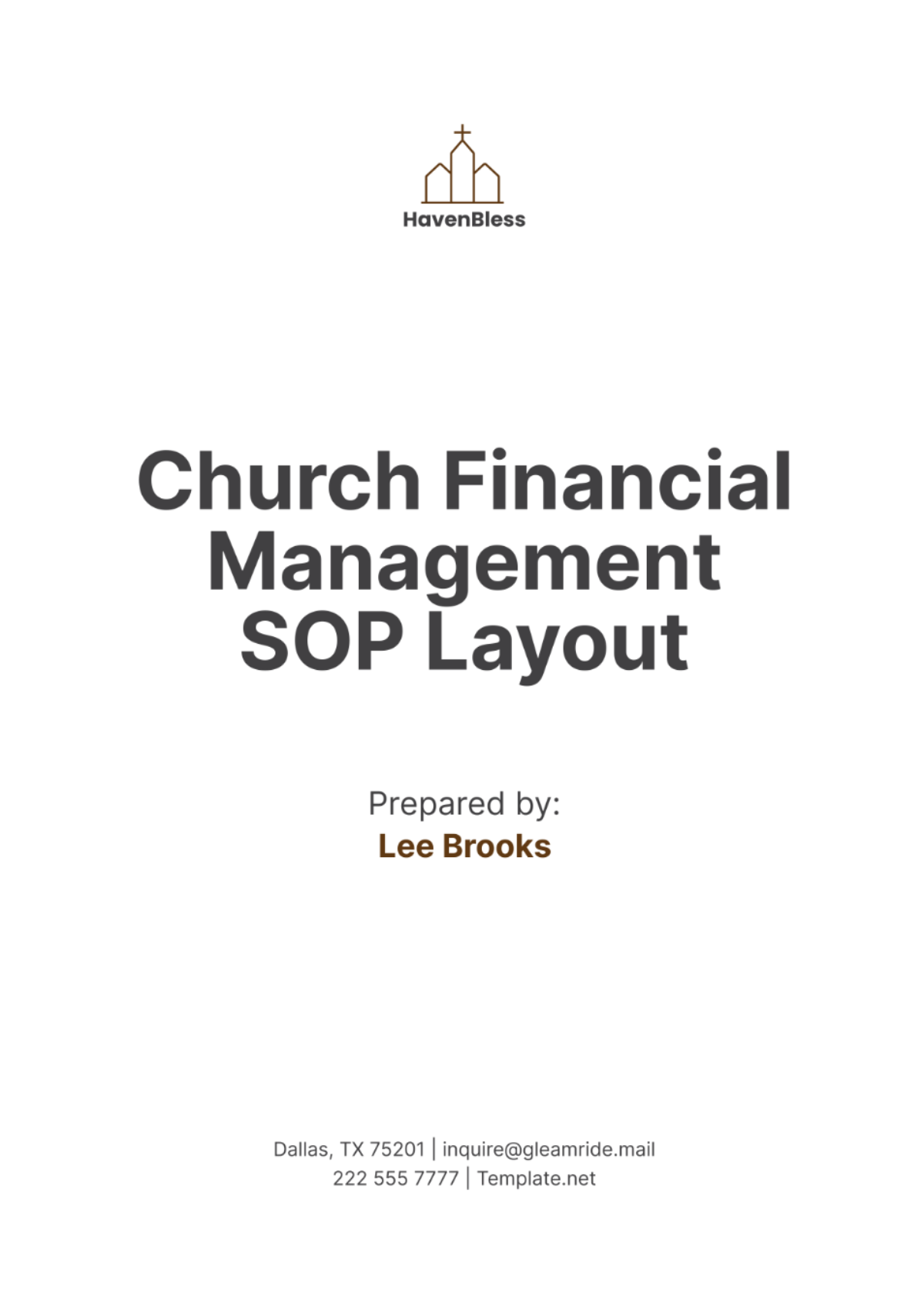Church Conflict Resolution SOP Sample
I. Introduction
A. Purpose
Promote Harmony: The purpose of this Church Conflict Resolution SOP is to promote harmony and resolve conflicts within [Your Company Name]. Effective conflict resolution fosters a peaceful and supportive church environment.
Provide Guidelines: This document provides clear guidelines for addressing and managing conflicts among church members, staff, and leadership. It ensures a structured approach to conflict resolution.
Encourage Communication: Encouraging open communication and understanding is key. This SOP outlines steps to facilitate dialogue and mutual respect among all parties involved.
B. Scope
Applicable Conflicts: The SOP applies to conflicts arising within the church community, including interpersonal disputes, disagreements over church policies, and issues related to church activities.
Involved Parties: It covers conflicts involving church members, staff, volunteers, and leadership. The procedures are designed to address conflicts at all levels.
Resolution Methods: Various resolution methods are detailed, including mediation, arbitration, and formal complaint processes. These methods aim to resolve conflicts in a fair and just manner.
C. Target Audience
Church Leadership: This SOP is intended for church leadership, including pastors, elders, and deacons, who play a critical role in conflict resolution.
Staff and Volunteers: Church staff and volunteers are also key users of this SOP. It provides them with the necessary tools and procedures to manage conflicts effectively.
Church Members: While primarily for leadership and staff, the SOP is also relevant for church members who may be involved in or affected by conflicts. It helps them understand the process and their role in resolution.
II. Conflict Identification
The following table provides an overview of the steps involved in identifying conflicts within the church:
No. | Step | Description |
|---|---|---|
1 | Observation | Noticing signs of conflict among members or staff. |
2 | Reporting | Reporting conflicts to church leadership. |
3 | Initial Assessment | Conducting a preliminary assessment of the conflict. |
4 | Documentation | Documenting the conflict details and initial findings. |
5 | Communication | Communicating with involved parties to understand the issue. |
A. Observation
Recognize Signs: Be vigilant in recognizing signs of conflict, such as changes in behavior, decreased participation, or verbal disputes. Early identification is crucial for timely intervention.
Monitor Interactions: Pay attention to interactions among church members and staff. Consistent monitoring can help detect conflicts before they escalate.
Encourage Reporting: Encourage church members and staff to report conflicts or signs of tension. A proactive approach can prevent issues from worsening.
Provide Training: Train church leaders and staff to identify potential conflicts. Awareness and skill development in conflict identification are essential.
B. Reporting
Establish Channels: Establish clear reporting channels for conflicts. Ensure that all members and staff know how and where to report issues.
Ensure Confidentiality: Maintain confidentiality during the reporting process. This encourages individuals to come forward without fear of retribution.
Designate Contacts: Designate specific individuals or committees responsible for receiving and handling conflict reports. This ensures accountability and efficiency.
Acknowledge Reports: Acknowledge receipt of conflict reports promptly. This reassures the reporting party that their concerns are being taken seriously.
C. Initial Assessment
Gather Information: Gather relevant information from all parties involved in the conflict. This includes personal accounts, witness statements, and any other pertinent data.
Evaluate Severity: Evaluate the severity of the conflict. Determine whether it requires immediate intervention or can be managed through standard resolution processes.
Identify Underlying Issues: Identify any underlying issues that may have contributed to the conflict. Understanding the root causes is vital for effective resolution.
Develop a Preliminary Plan: Develop a preliminary plan for addressing the conflict. This plan should outline the initial steps and potential resolution methods.
D. Documentation
Record Details: Record all details of the conflict, including dates, times, locations, and individuals involved. Accurate documentation is crucial for transparency and accountability.
Maintain Records: Maintain records of all conflict reports and related documentation. These records should be securely stored and accessible only to authorized personnel.
Update Regularly: Update documentation regularly as new information becomes available or as the resolution process progresses. Keeping records current ensures clarity and continuity.
Review Periodically: Periodically review conflict documentation to identify patterns or recurring issues. This can help in developing preventive measures for future conflicts.
E. Communication
Engage with Parties: Engage with all parties involved in the conflict. Open communication is essential for understanding perspectives and finding common ground.
Facilitate Dialogue: Facilitate constructive dialogue between conflicting parties. Encourage active listening and respectful expression of concerns.
Clarify Issues: Clarify the issues at hand and ensure that all parties have a clear understanding of the conflict. Misunderstandings can often escalate conflicts unnecessarily.
Establish Goals: Establish common goals for resolution. Identifying shared objectives can help align efforts and foster cooperation.
Identifying conflicts early and addressing them through structured processes is crucial for maintaining harmony within the church community. Accurate documentation and open communication are key components in managing conflicts effectively.
III. Conflict Resolution Processes
The following table provides an overview of the steps involved in resolving conflicts within the church:
No. | Step | Description |
|---|---|---|
1 | Mediation | Facilitating a discussion between parties to reach a mutual agreement. |
2 | Arbitration | Appointing a neutral party to make a binding decision. |
3 | Formal Complaint | Filing a formal complaint for serious or unresolved conflicts. |
4 | Resolution Meeting | Holding a meeting to discuss and resolve the conflict. |
5 | Follow-Up | Ensuring the conflict is fully resolved and no further issues arise. |
A. Mediation
Select Mediator: Select a neutral mediator who is respected by all parties involved. The mediator should be trained in conflict resolution techniques.
Set Ground Rules: Establish ground rules for the mediation process. These should include guidelines for respectful communication and confidentiality.
Facilitate Discussion: The mediator facilitates a discussion between the parties, encouraging them to express their perspectives and listen to each other.
Seek Agreement: Aim to reach a mutual agreement that addresses the concerns of all parties. The agreement should be documented and signed by all involved.
Monitor Implementation: Monitor the implementation of the agreed-upon resolution. Ensure that all parties adhere to their commitments.
B. Arbitration
Appoint Arbitrator: Appoint a neutral arbitrator who has the authority to make a binding decision. The arbitrator should be impartial and experienced in conflict resolution.
Present Cases: Both parties present their cases to the arbitrator, providing evidence and arguments. This process should be fair and transparent.
Review Evidence: The arbitrator reviews all evidence and testimonies. This includes considering any relevant documents, witness statements, and contextual factors.
Make Decision: The arbitrator makes a binding decision based on the evidence presented. The decision should be communicated clearly to both parties.
Implement Decision: Ensure that the arbitrator’s decision is implemented promptly. Follow up to confirm that the conflict has been resolved according to the decision.
C. Formal Complaint
File Complaint: File a formal complaint if the conflict cannot be resolved through mediation or arbitration. The complaint should be detailed and supported by evidence.
Assign Investigator: Assign an investigator to review the complaint. The investigator should be impartial and thorough in their examination of the issue.
Conduct Investigation: The investigator conducts a detailed investigation, interviewing involved parties and gathering relevant information.
Report Findings: The investigator reports their findings to church leadership, including recommendations for resolution.
Take Action: Based on the investigation report, church leadership takes appropriate action to resolve the conflict. This may include disciplinary measures or policy changes.
D. Resolution Meeting
Schedule Meeting: Schedule a resolution meeting with all parties involved. Ensure that the timing and location are convenient and conducive to open discussion.
Set Agenda: Set an agenda for the meeting, outlining the topics to be discussed and the desired outcomes. This helps keep the discussion focused and productive.
Facilitate Discussion: Facilitate a structured discussion, allowing each party to express their views and propose solutions. Encourage respectful dialogue and collaboration.
Reach Consensus: Aim to reach a consensus on how to resolve the conflict. Document the agreed-upon resolution and ensure that all parties commit to it.
Follow Up: Follow up after the meeting to ensure that the resolution is being implemented and that no further issues have arisen.
E. Follow-Up
Monitor Resolution: Continuously monitor the resolution process to ensure it is effective. Regular check-ins can help identify any lingering issues or new conflicts.
Provide Support: Provide support to all parties involved, including counseling or mediation services if needed. Support helps maintain a positive environment.
Evaluate Outcome: Evaluate the outcome of the resolution process. Determine whether the conflict was fully resolved and whether the solution was satisfactory for all parties.
Document Lessons Learned: Document any lessons learned from the conflict resolution process. These insights can help improve future conflict management practices.
Resolving conflicts effectively requires a structured and fair approach. By following these processes, [Your Company Name] can ensure that conflicts are addressed in a manner that promotes understanding, reconciliation, and community harmony.
IV. Mediation Procedures
The following table provides an overview of the steps involved in the mediation process:
No. | Step | Description |
|---|---|---|
1 | Preparation | Preparing for the mediation session. |
2 | Opening Statements | Allowing each party to make an opening statement. |
3 | Issue Identification | Identifying the key issues and concerns. |
4 | Negotiation | Facilitating negotiation between the parties. |
5 | Agreement | Reaching and documenting a mutual agreement. |
6 | Follow-Up | Monitoring the implementation of the agreement. |
A. Preparation
Schedule Session: Schedule a mediation session at a mutually convenient time. Ensure that all parties are available and willing to participate.
Select Venue: Choose a neutral and comfortable venue for the mediation. The environment should promote open and respectful communication.
Gather Information: Gather all relevant information and documents related to the conflict. This helps the mediator understand the context and prepare effectively.
Set Agenda: Set a clear agenda for the mediation session. Outline the topics to be discussed and the goals of the mediation.
Prepare Parties: Prepare the parties for the mediation by explaining the process and setting expectations. This helps them feel more comfortable and engaged.
B. Opening Statements
Explain Process: The mediator explains the mediation process to all parties, including the rules and guidelines for the session. This ensures everyone understands the structure and purpose.
Invite Statements: Invite each party to make an opening statement. This allows them to express their perspectives and concerns without interruption.
Encourage Respect: Encourage respect and active listening during opening statements. Remind parties to avoid personal attacks and focus on the issues.
Take Notes: The mediator takes notes during the opening statements to capture key points and concerns. These notes will be used to guide the discussion.
C. Issue Identification
List Issues: List the key issues and concerns identified during the opening statements. This helps focus the discussion on the most important aspects of the conflict.
Prioritize Issues: Prioritize the issues based on their impact and importance. Addressing the most critical issues first can help create momentum for resolution.
Clarify Concerns: Clarify any concerns or misunderstandings that may arise. Ensure that all parties have a clear understanding of the issues.
Set Goals: Set goals for the mediation session, aiming to address and resolve the identified issues. Clear goals provide direction and purpose.
D. Negotiation
Facilitate Dialogue: Facilitate a dialogue between the parties, encouraging them to propose solutions and compromises. Active listening and empathy are crucial during this stage.
Explore Options: Explore various options and alternatives for resolving the conflict. Consider creative solutions that meet the needs and interests of both parties.
Address Barriers: Identify and address any barriers to resolution, such as misunderstandings, emotions, or external factors. Overcoming these barriers is essential for progress.
Seek Consensus: Seek consensus on the proposed solutions. Ensure that both parties agree on the terms and are willing to commit to the resolution.
Document Agreement: Document the agreement in detail, outlining the specific actions and commitments of each party. A written agreement provides clarity and accountability.
E. Agreement
Review Terms: Review the terms of the agreement with both parties to ensure understanding and acceptance. Address any questions or concerns they may have.
Sign Agreement: Have both parties sign the agreement to formalize their commitment. The signed agreement should be kept on record for future reference.
Plan Implementation: Develop a plan for implementing the agreement. Outline the steps and timelines for fulfilling the commitments made during mediation.
Assign Responsibilities: Assign specific responsibilities to each party for implementing the agreement. Ensure that everyone knows their role and tasks.
Monitor Progress: Monitor the progress of the implementation to ensure that the agreement is being followed. Regular check-ins can help address any issues that arise.
Provide Support: Provide support to the parties during the implementation phase. This may include additional mediation sessions, counseling, or resources as needed.
F. Follow-Up
Schedule Follow-Up: Schedule follow-up meetings to review the progress of the agreement. Regular follow-ups help maintain accountability and ensure compliance.
Evaluate Outcome: Evaluate the outcome of the mediation and the effectiveness of the agreement. Gather feedback from the parties to assess their satisfaction.
Address Issues: Address any issues or challenges that arise during the implementation. Be proactive in finding solutions and maintaining communication.
Document Results: Document the results of the mediation and any follow-up actions taken. This provides a record of the resolution process and outcomes.
Mediation is a vital process for resolving conflicts within the church community. By following these procedures, [Your Company Name] can ensure that conflicts are addressed in a fair, respectful, and effective manner.
V. Arbitration Procedures
The following table provides an overview of the steps involved in the arbitration process:
No. | Step | Description |
|---|---|---|
1 | Request for Arbitration | Submitting a request for arbitration to the church leadership. |
2 | Appointment of Arbitrator | Appointing a neutral arbitrator to oversee the process. |
3 | Hearing Preparation | Preparing for the arbitration hearing. |
4 | Arbitration Hearing | Conducting the arbitration hearing. |
5 | Decision Making | Making a binding decision based on the evidence. |
6 | Implementation | Implementing the arbitrator’s decision. |
A. Request for Arbitration
Submit Request: Submit a formal request for arbitration to church leadership. The request should detail the nature of the conflict and the parties involved.
Provide Documentation: Provide all relevant documentation and evidence to support the request. This includes any previous attempts at resolution and correspondence.
Review Request: Church leadership reviews the request to determine its validity and whether arbitration is appropriate. This ensures the process is necessary and justified.
Notify Parties: Notify all parties involved about the arbitration request and process. Clear communication ensures transparency and preparation.
B. Appointment of Arbitrator
Select Arbitrator: Select a neutral arbitrator who has no personal interest in the conflict. The arbitrator should be impartial and experienced in conflict resolution.
Confirm Acceptance: Confirm the acceptance of the arbitrator by all parties involved. Mutual agreement on the arbitrator’s neutrality is essential for fairness.
Set Timeline: Set a timeline for the arbitration process, including deadlines for submitting evidence and scheduling the hearing.
Provide Guidelines: Provide guidelines for the arbitration process, including rules of conduct, evidence submission, and hearing procedures.
C. Hearing Preparation
Gather Evidence: Gather all necessary evidence and documentation to present during the arbitration hearing. This includes statements, records, and any relevant materials.
Prepare Statements: Prepare opening and closing statements for the hearing. These statements should clearly outline the key points and desired outcomes.
Notify Witnesses: Notify any witnesses who will be called to testify during the hearing. Ensure they are available and prepared to provide their testimony.
Review Procedures: Review the arbitration procedures with all parties to ensure understanding and compliance. This helps prevent misunderstandings during the hearing.
D. Arbitration Hearing
Conduct Hearing: Conduct the arbitration hearing according to the established procedures. Ensure that all parties have an equal opportunity to present their case.
Present Evidence: Both parties present their evidence and arguments. The arbitrator may ask questions and seek clarification as needed.
Hear Witnesses: Witnesses provide their testimony, and the arbitrator evaluates their credibility and relevance to the case.
Record Proceedings: Record the proceedings to maintain an accurate and detailed account of the hearing. This record can be referenced in the decision-making process.
E. Decision Making
Review Evidence: The arbitrator reviews all evidence and testimonies presented during the hearing. This thorough review is crucial for a fair decision.
Consider Context: Consider the context and background of the conflict, including any relevant church policies or practices.
Draft Decision: Draft a written decision that outlines the arbitrator’s findings and the binding resolution. The decision should be clear, detailed, and justified.
Communicate Decision: Communicate the decision to all parties involved. Ensure that the decision is understood and accepted as final and binding.
F. Implementation
Develop Implementation Plan: Develop a plan for implementing the arbitrator’s decision. This plan should include specific actions and timelines.
Assign Responsibilities: Assign responsibilities for carrying out the implementation plan. Ensure that all parties know their roles and tasks.
Monitor Compliance: Monitor compliance with the arbitrator’s decision. Regular check-ins help ensure that the resolution is being followed and effective.
Provide Support: Provide support to all parties during the implementation phase. This may include additional resources, counseling, or mediation as needed.
Arbitration provides a structured and binding resolution process for conflicts that cannot be resolved through mediation. By following these procedures, [Your Company Name] ensures that conflicts are resolved fairly and effectively.
VI. Formal Complaint Procedures
The following table provides an overview of the steps involved in the formal complaint process:
No. | Step | Description |
|---|---|---|
1 | Complaint Submission | Submitting a formal complaint to church leadership. |
2 | Initial Review | Conducting an initial review of the complaint. |
3 | Investigation | Conducting a thorough investigation of the complaint. |
4 | Findings Report | Reporting the findings of the investigation. |
5 | Decision and Action | Making a decision and taking appropriate action. |
6 | Follow-Up | Following up to ensure resolution and compliance. |
A. Complaint Submission
Submit Complaint: Submit a detailed formal complaint to church leadership. The complaint should include the nature of the conflict, involved parties, and any supporting evidence.
Acknowledge Receipt: Church leadership acknowledges receipt of the complaint promptly. This reassures the complainant that their concerns are being addressed.
Assign Investigator: Assign an impartial investigator to handle the complaint. The investigator should have no personal interest in the conflict.
Inform Parties: Inform all parties involved about the complaint and the investigation process. Clear communication is essential for transparency and cooperation.
B. Initial Review
Review Complaint: Conduct an initial review of the complaint to determine its validity and the appropriate course of action. This review should be thorough and unbiased.
Gather Preliminary Information: Gather preliminary information and evidence related to the complaint. This includes any previous attempts at resolution and relevant documents.
Determine Next Steps: Determine the next steps based on the initial review. This may include proceeding with a full investigation or seeking alternative resolution methods.
Communicate Plan: Communicate the plan for addressing the complaint to all parties. Ensure that everyone understands the process and their role in it.
C. Investigation
Conduct Interviews: Conduct interviews with all parties involved in the complaint. This includes the complainant, the accused, and any witnesses.
Gather Evidence: Gather all relevant evidence, including documents, emails, and any other materials that may support the investigation.
Analyze Information: Analyze the information and evidence gathered to identify key facts and determine the validity of the complaint.
Maintain Confidentiality: Maintain confidentiality throughout the investigation process to protect the privacy of all parties involved.
D. Findings Report
Prepare Report: Prepare a detailed report outlining the findings of the investigation. The report should include a summary of the evidence, interviews, and key findings.
Provide Recommendations: Provide recommendations for resolving the complaint based on the findings. These recommendations should be fair and objective.
Review with Leadership: Review the findings report with church leadership. This ensures that the decision-making process is informed and collaborative.
Communicate Findings: Communicate the findings and recommendations to all parties involved. Ensure that the findings are clearly understood and accepted.
E. Decision and Action
Make Decision: Church leadership makes a decision based on the findings report and recommendations. The decision should be fair, impartial, and justified.
Implement Action: Implement the necessary actions to resolve the complaint. This may include disciplinary measures, policy changes, or other corrective actions.
Inform Parties: Inform all parties of the decision and the actions to be taken. Ensure that the communication is clear and detailed.
Document Outcome: Document the outcome of the complaint and the actions taken. This provides a record for future reference and accountability.
F. Follow-Up
Monitor Implementation: Monitor the implementation of the actions taken to ensure compliance and effectiveness. Regular follow-ups help maintain accountability.
Evaluate Resolution: Evaluate the resolution to determine whether the complaint has been fully addressed and resolved. Gather feedback from all parties involved.
Address Additional Issues: Address any additional issues or concerns that may arise during the follow-up process. Be proactive in finding solutions and maintaining communication.
Provide Support: Provide ongoing support to all parties as needed. This may include counseling, mediation, or other resources to ensure a positive resolution.
Formal complaints provide a structured process for addressing serious conflicts within the church. By following these procedures, [Your Company Name] ensures that complaints are handled fairly, transparently, and effectively.
VII. Conflict Prevention Strategies
The following table provides an overview of the steps involved in preventing conflicts within the church:
No. | Strategy | Description |
|---|---|---|
1 | Communication Training | Providing training on effective communication skills. |
2 | Team Building | Conducting team-building activities to foster unity. |
3 | Policy Development | Developing clear policies and guidelines. |
4 | Regular Feedback | Encouraging regular feedback and open dialogue. |
5 | Conflict Resolution Workshops | Offering workshops on conflict resolution. |
6 | Support Systems | Establishing support systems for members and staff. |
A. Communication Training
Identify Needs: Identify the communication training needs of church members and staff. This includes assessing current communication skills and areas for improvement.
Develop Curriculum: Develop a curriculum for communication training that includes key topics such as active listening, nonverbal communication, and conflict resolution.
Schedule Sessions: Schedule regular training sessions for all church members and staff. Ensure that the sessions are accessible and convenient for everyone.
Engage Trainers: Engage experienced trainers to conduct the sessions. Trainers should have expertise in communication and conflict resolution.
Evaluate Impact: Evaluate the impact of the training on communication within the church. Gather feedback from participants to assess the effectiveness and identify areas for improvement.
B. Team Building
Plan Activities: Plan team-building activities that promote unity and collaboration among church members and staff. These activities should be enjoyable and inclusive.
Facilitate Participation: Encourage participation from all members and staff. Ensure that everyone feels included and valued during the activities.
Promote Interaction: Promote interaction and teamwork during the activities. This helps build relationships and fosters a sense of community.
Reflect on Experience: Reflect on the experience after each activity. Discuss what was learned and how it can be applied to improve teamwork and unity.
Follow-Up Activities: Schedule follow-up activities to maintain momentum and continue building relationships. Regular team-building events help reinforce unity and collaboration.
C. Policy Development
Identify Gaps: Identify gaps in current policies and guidelines. Assess whether existing policies adequately address potential sources of conflict.
Engage Stakeholders: Engage stakeholders in the policy development process. This includes church leadership, staff, and members.
Draft Policies: Draft clear and comprehensive policies that address identified gaps. Ensure that policies are fair, inclusive, and aligned with the church’s values.
Review and Approve: Review the draft policies with all stakeholders. Make any necessary revisions before seeking approval from church leadership.
Communicate Policies: Communicate the new policies to all members and staff. Ensure that everyone understands the policies and their importance.
D. Regular Feedback
Establish Channels: Establish clear channels for providing regular feedback. This includes anonymous suggestion boxes, online forms, and regular meetings.
Encourage Participation: Encourage all members and staff to participate in providing feedback. Create a safe and supportive environment for open dialogue.
Respond Promptly: Respond promptly to feedback received. Acknowledge the input and take appropriate action to address concerns.
Implement Changes: Implement changes based on feedback. Ensure that improvements are communicated to the church community.
Evaluate Impact: Evaluate the impact of the changes made. Gather feedback on the effectiveness and make further adjustments as needed.
E. Conflict Resolution Workshops
Identify Topics: Identify key topics for conflict resolution workshops. This includes common sources of conflict, resolution techniques, and best practices.
Schedule Workshops: Schedule regular workshops for all members and staff. Ensure that the timing and location are convenient for maximum participation.
Engage Experts: Engage conflict resolution experts to conduct the workshops. Experts should have experience in managing conflicts within church or community settings.
Interactive Sessions: Design interactive sessions that encourage participation and practical learning. Include role-playing, group discussions, and case studies.
Evaluate Effectiveness: Evaluate the effectiveness of the workshops. Gather feedback from participants to assess their impact and identify areas for improvement.
F. Support Systems
Establish Support Groups: Establish support groups for members and staff. These groups provide a safe space for sharing concerns and seeking advice.
Provide Counseling Services: Provide access to professional counseling services for those in need. Counseling can help individuals manage stress and resolve personal conflicts.
Develop Mentorship Programs: Develop mentorship programs that pair experienced members or staff with those who may need guidance. Mentorship can provide valuable support and advice.
Promote Resources: Promote available resources, such as conflict resolution guides, workshops, and support groups. Ensure that everyone knows how to access these resources.
Evaluate Impact: Evaluate the impact of the support systems. Gather feedback from participants to assess their effectiveness and identify areas for improvement.
Preventing conflicts is essential for maintaining a harmonious and supportive church environment. By implementing these strategies, [Your Company Name] can proactively address potential sources of conflict and foster a positive community.
VIII. Continuous Improvement
A. Regular Training
Identify Training Needs: Regularly identify the training needs of church members and staff regarding conflict resolution. Assess current skills and knowledge gaps.
Develop Training Programs: Develop comprehensive training programs that address identified needs. Include topics such as effective communication, mediation techniques, and emotional intelligence.
Schedule Ongoing Sessions: Schedule ongoing training sessions to keep everyone updated on best practices and new strategies in conflict resolution.
Evaluate Training Impact: Continuously evaluate the impact of training programs. Collect feedback from participants to improve future sessions.
B. Feedback Mechanisms
Establish Feedback Channels: Establish multiple channels for receiving feedback on conflict resolution processes. This includes suggestion boxes, online forms, and regular meetings.
Encourage Honest Feedback: Encourage honest and constructive feedback from all members and staff. Ensure that everyone feels safe to express their opinions and experiences.
Review Feedback Regularly: Regularly review the feedback received to identify common issues and areas for improvement.
Implement Changes: Implement changes based on feedback to enhance conflict resolution processes. Communicate these changes to the church community.
C. Review
Annual Review: This Church Conflict Resolution SOP will be reviewed annually to ensure its continued relevance and effectiveness. The review process will involve church leadership, staff, and selected members.
Comprehensive Assessment: Conduct a comprehensive assessment of the SOP, including its impact on conflict resolution within the church. Gather data and feedback to inform the review.
Engage Experts: Engage conflict resolution experts to provide insights and recommendations during the review process. Their expertise will help identify areas for improvement.
Document Findings: Document the findings of the review process. This includes identifying successful aspects of the SOP and areas that require updates.
D. Community Engagement
Promote Awareness: Promote awareness of conflict resolution processes and resources within the church community. Use newsletters, announcements, and workshops.
Foster Open Dialogue: Foster an environment of open dialogue where members feel comfortable discussing conflicts and seeking resolution.
Encourage Participation: Encourage active participation from all members in conflict resolution initiatives. This includes attending workshops, providing feedback, and supporting each other.
Celebrate Successes: Celebrate successful conflict resolutions and improvements in community relationships. Recognize the efforts of individuals and groups involved.























